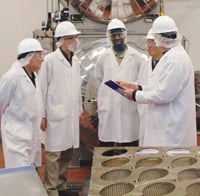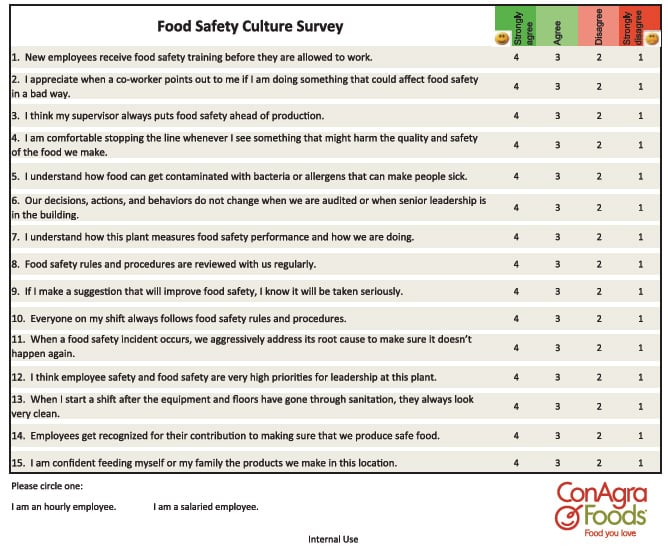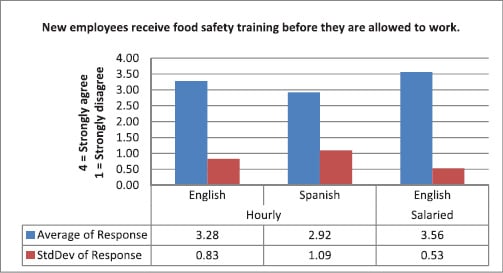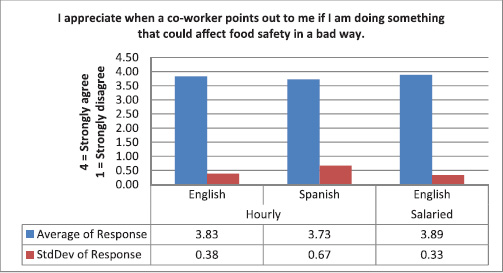Assessing the Food Safety Culture of a Manufacturing Facility
Methods and tools, such as surveying line workers as well as management personnel and conducting focus groups, can yield insightful data on how to produce safer food.
Given that the decisions, actions, and behaviors of all employees affect food safety, the concept of food safety culture has recently become a hot topic of discussion within the food industry as companies look to strengthen their food safety programs.
Essential to the production of safe food at manufacturing establishments is having the right mindset; that is the right culture to execute food safety policies and procedures that govern plant operations. A strong food safety culture at the production plant will help drive the day-to-day decisions, actions, and behaviors that will help to ensure the production of safe food.
Food safety culture is driven by the management team at the manufacturing facility through the communications and interactions with those partners working at the plant, and by the decisions the management team makes relative to raw materials, in-plant processes, employee practices, training, and finished product disposition. The management team must set the reward and recognition processes that reinforce food safety.
The food safety culture at ConAgra Foods is our core beliefs reflected in those daily decisions, actions, and behaviors that deliver safe and wholesome foods. Our four core beliefs are:
1. Cultivate. Leadership is responsible for developing and communicating the commitment to food safety, the food safety objectives, and ensuring that the objectives are met.
2. Educate. Employees at all levels shall have the necessary training and skills to be empowered to promote and execute good food safety decisions and practices.
3. Investigate. It is imperative to look for what we don’t want to see and to act on any findings that do not meet our expectations. It also is important to incorporate knowledge of scientific and industry advances discovered through investigation.
4. Improve and Elevate. System failures are taken seriously and are used as continuous improvement opportunities.
--- PAGE BREAK ---
Two of the best references on food safety culture have been written by Yiannis (2009) and Powell et al. (2011). Both publications point out the need to understand the food safety culture at a manufacturing establishment, as it is the basis for decisions, actions, and behaviors that impact the safety of the food being produced.
In order to understand the status of the food safety culture at a manufacturing facility, you should conduct a formal assessment. Results of the assessment can then be used to determine which areas, if any, need to be addressed. Additionally, improvements implemented to improve food safety culture can be measured or tracked by reassessing the culture several months later.
Yiannis presents examples of survey questions that could be part of an overall communications plan on food safety culture. But there is an absence in the literature of how to measure or assess food safety culture.
Following is a description of implementing a food safety culture measurement system in a manufacturing facility.
Tools to Measure Food Safety Culture
Methods and tools for assessing and measuring the state of the food safety culture in a manufacturing facility include a plant employee survey, focus groups to be conducted post-survey, a questionnaire for plant management, and the assessment of pre-shift huddles with line workers and visual and written communications in the plant that address food safety. After deploying these methods and reviewing the results, you can make an overall assessment with recommendations.
Administering a survey to all plant personnel—line workers as well as supervisors and management—is the first step in the assessment process. Having all employees take part in the survey is important, as it sets the stage for communicating that everyone contributes to the plant’s food safety culture and that food safety is everyone’s responsibility. The act itself of taking the survey increases awareness of the concept of food safety culture, gets people talking about food safety culture, and ultimately drives toward improvements.
 The survey should consist of statements that will allow assessment of the engagement and commitment of management, supervisors, and workers toward making safe food (Table 1). The degree of agreement or disagreement with each statement by those taking the survey is indicated by a numeric response from one to four. You can use the numeric responses to provide average scores and standard deviations for each statement.
The survey should consist of statements that will allow assessment of the engagement and commitment of management, supervisors, and workers toward making safe food (Table 1). The degree of agreement or disagreement with each statement by those taking the survey is indicated by a numeric response from one to four. You can use the numeric responses to provide average scores and standard deviations for each statement.
--- PAGE BREAK ---
Numerous considerations in developing and administering the survey will affect the results. These include the introductory remarks, the setting in which the survey is presented, the overall look of the survey, whether the survey is translated into the common languages of the personnel, and the literacy of employees. If literacy limits comprehension by some employees, you should read each statement aloud to the entire group and only move on to the next statement after everyone has had the opportunity to ask for clarification and respond.
To allow for consistency across shifts (i.e., day, night, afternoon), plants, and time, pre-written survey directions should be read aloud to employees by the administrator. To analyze results most effectively, keep surveys separated by shift, and have participants note whether they are hourly or salaried employees. Also, since surveys should be translated to all languages used in the plant, responses can be sorted by language as well.
With this information, you can ascertain if one shift presents more opportunities than another, for example, or whether there are differences between supervisors and line workers.
Survey data provide guidance on topics for discussion in the focus groups. Using a neutral moderator, conduct three or more focus groups of 10 or fewer employees to confirm survey responses and the assumptions derived from them to get additional insights around the responses, and to discuss any other issues related to food safety culture that the survey may not have revealed. All employee language groups must be represented, as well as all shifts. It is advisable to conduct a focus group that includes supervisors and other individuals that make decisions affecting food safety, such as procurement or human resources personnel.
A management questionnaire ascertains how management views and approaches food safety culture. The questionnaire is a hybrid of a survey, management interview, data review, and best practices discovery. The questionnaire is user-friendly; it can be filled out at the individual’s convenience and enables consistent, temporal comparisons should a food safety review be repeated at a later date. By having the management team complete the questionnaire individually, an assessment can be made on the alignment of all team members on the food safety goals. The questionnaire is the basis for a management review of food safety culture. Having the written responses in advance of the management team meeting facilitates a more productive dialogue.
--- PAGE BREAK ---
What is regularly discussed in a pre-shift huddle reinforces to employees on a daily basis what is important. How the team leader presents information on food safety, and how that information appears to be received by the listeners, can indicate sincerity by the team leader and interest by the employees to make the effort to positively impact food safety. Attending a team huddle before each shift will enable observations on what and how information is conveyed. Examples of items to be aware of while observing a pre-shift huddle include:
• Food safety is part of the pre-shift huddle agenda.
• Food safety metrics are posted on scoreboards before the huddle.
• A translator is present if bilingual communication is necessary.
• Participants and the facilitator recognize employee contributions to food safety.
• Employees appear to be listening and display food safety engagement by asking relevant questions.
Part of the assessment involves a plant walk-through, looking for how food safety messaging is conveyed. It is important to assess whether posters and signs are current with fresh messages, whether newsletters include food safety as a regular topic, and whether flyers are used to communicate recent food safety incidents.
Assessment Results
Figures 1 and 2 illustrate the type of data that result from application of the food safety culture survey. Focus group observations can be categorized into core themes. The top observations for several themes in one assessment, for example, conducted by ConAgra were:


1. Employee desire
• Both employees and leaders want food safety held up as an equal to personal safety, with both groups talking about the need to inspire employees around food safety.
• Participants said they specifically wanted to know more about lessons learned from food safety issues and incidents and how they would prevent future problems.
--- PAGE BREAK ---
2. Teamwork
• Employees want to be able to rely on one another.
• Employees felt that there needs to be a good balance of supervisor responsibility and their own responsibility, but felt that at the end of the day, they are personally accountable.
3. Recognition
• Employees were proud of the plant’s food safety performance and understood that it deserved recognition. Recognition breeds motivation.
• Suggestions were made to reinstitute food safety and recognition committees to help drive engagement from the floor.
The final stage of the assessment is the use of the measurement data to prepare recommendations to improve, if necessary, the facility’s food safety culture. In the assessments conducted to date, the improvement strategies included enhancement to the training programs, such as:
1. The use of on-the-floor demonstrations using equipment and other props.
2. More frequent retraining of supervisors on their role in consistently reinforcing the positive food safety behaviors demonstrated by employees.
3. Verification of new employees’ comprehension of the food safety training they received before being allowed to work.
--- PAGE BREAK ---
Strategies also included a focus on enhanced review of sanitary design of the facility and equipment, on the capture of employee suggestions to enhance food safety, and on employee recognition. Implementation of these strategies included the following actions:
1. Semi-annual use of the ConAgra sanitary design checklist.
2. Active solicitation by supervisors and management of ideas from line workers on means to enhance food safety behaviors.
3. Implementation of the corporate employee recognition program at the manufacturing establishment. This program allows for any one individual at any level to formally recognize another employee.
The impact of these strategies and actions on enhancing food safety will be confirmed through a repeat of the assessment process. The successes at the different plants become best practices that can be shared across the entire network of manufacturing facilities.
Due to its infancy, the measurement of food safety culture is more art than science. The goal at hand is to build upon and enhance the measurement process to yield greater knowledge and insight that will ultimately lead to production of safer foods.
Robert (Skip) Seward, a Professional Member of IFT, is Vice President – Global Food Safety ( [email protected] ), Nancy Dobmeier is Senior Microbiologist – Food Safety and Microbiology ( [email protected] ), and Melissa Baron is Director – Communications ( [email protected] ), ConAgra Foods, Omaha, NE 68102.
References
Powell, D.A., Jacob, C.J., and Chapman, B.J. 2011. Enhancing food safety culture to reduce rates of foodborne illness. Food Control 22(6): 817-822.
Yiannis, F. 2009. “Food Safety Culture: creating a behavior-based food safety management system.” Springer Science, New York.
